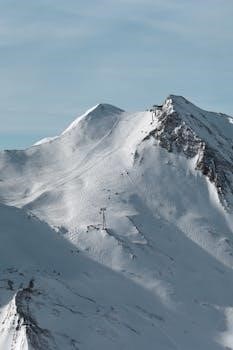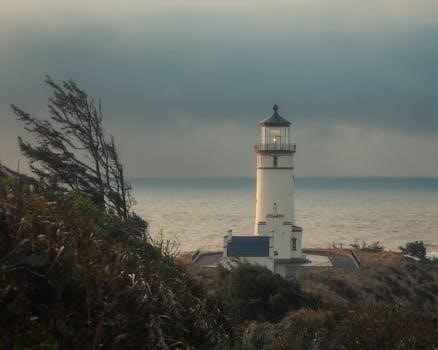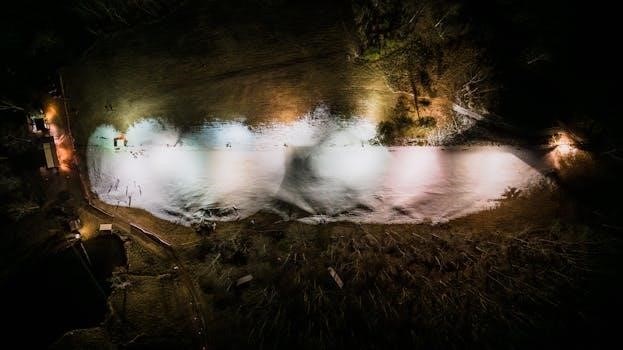Ski Size Guide⁚ Finding the Perfect Fit
Choosing the correct ski size is vital for optimal performance and enjoyment on the slopes․ Factors like height‚ weight‚ and skill influence the ideal ski length․ This guide simplifies the process of finding your perfect fit‚ ensuring a great ski experience․
Selecting the appropriate ski size is a crucial step for both novice and experienced skiers․ The length of your skis significantly impacts your control‚ stability‚ and overall enjoyment on the mountain․ This guide aims to demystify the ski sizing process‚ offering clear and concise information to help you make an informed decision․
Understanding the basics of ski sizing involves considering several key factors‚ including your height‚ weight‚ skill level‚ and the type of terrain you plan to ski․ By taking these elements into account‚ you can narrow down the range of suitable ski lengths and ensure a more comfortable and efficient skiing experience․
The correct ski size allows you to turn effectively‚ maintain balance‚ and navigate various snow conditions with confidence․ Whether you are carving down groomers or exploring off-piste terrain‚ the right ski size will enhance your performance and maximize your fun on the slopes․
Factors Influencing Ski Size
Determining the ideal ski size involves considering several key factors that collectively influence your skiing experience․ Height and weight are primary considerations‚ as they directly impact the amount of ski surface area needed for stability and control․ A taller or heavier skier generally requires longer skis to maintain balance and effectively initiate turns․
Skill level also plays a significant role‚ with beginners often benefiting from shorter skis that are easier to maneuver․ As skiers progress and gain confidence‚ they may opt for longer skis to enhance stability at higher speeds․
Finally‚ the type of terrain you intend to ski on should also be considered․ All-mountain skis are designed for versatility‚ while powder skis are wider and longer for optimal floatation in deep snow․ Understanding these factors is essential for selecting the appropriate ski size and maximizing your enjoyment on the slopes․
Skier Height and Weight
Height and weight are fundamental in determining the appropriate ski length․ These factors directly influence the skier’s center of gravity and the amount of surface area needed for stability and control․ Generally‚ taller skiers require longer skis to maintain balance and effectively distribute their weight across the ski․ Similarly‚ heavier skiers need longer skis to prevent the skis from sinking too much into the snow‚ which can hinder performance and maneuverability․
A ski that is too short may feel unstable‚ especially at higher speeds‚ while a ski that is too long can be difficult to turn and control‚ particularly for beginners․
Therefore‚ accurately assessing your height and weight is crucial for selecting a ski size that provides optimal performance and safety on the slopes․ Using a ski size chart that incorporates both height and weight is an excellent starting point for finding the right fit․
Skill Level (Beginner‚ Intermediate‚ Expert)

A skier’s skill level greatly influences the appropriate ski length․ Beginners typically benefit from shorter skis‚ which are easier to control and maneuver‚ allowing for quicker turns and a more forgiving learning experience․ Shorter skis enhance confidence and reduce the likelihood of catching an edge‚ making them ideal for building fundamental skills․
Intermediate skiers‚ who have developed basic skills and are comfortable on a variety of slopes‚ often prefer skis that are slightly longer than those used by beginners․ This provides increased stability at higher speeds and better performance in varied snow conditions․
Expert skiers‚ seeking maximum performance and control‚ often opt for longer skis that offer superior stability and edge hold‚ especially when tackling challenging terrain or skiing at high speeds․ The longer length provides enhanced floatation in powder and increased confidence when carving aggressive turns․
Skiing Style and Terrain Preference

A skier’s style and terrain preference play a crucial role in determining the ideal ski size․ Skiers who primarily frequent groomed runs and enjoy making precise‚ carved turns may prefer skis that are slightly shorter‚ offering enhanced maneuverability and edge control on hardpack snow․
Those who venture off-piste into softer snow conditions‚ or prefer a more playful‚ freestyle-oriented approach‚ might opt for wider skis that provide increased floatation and stability in deeper snow․ Skiers who enjoy high speeds and aggressive carving on varied terrain will often choose longer skis for greater stability and edge hold․
Ultimately‚ the choice depends on the balance between maneuverability and stability desired by the skier‚ and the type of terrain they expect to encounter most frequently․ Considering these factors ensures a more enjoyable and efficient experience on the mountain․
Ski Size Chart⁚ A General Guide
A ski size chart serves as a fundamental starting point for selecting the appropriate ski length‚ offering a range of recommended sizes based on a skier’s height and weight․ These charts provide a general guideline‚ acknowledging that individual preferences and skiing styles can significantly influence the final decision․
The chart typically presents measurements in both metric (cm/kg) and imperial (in/lbs) units for easy reference․ It’s important to note that the values within the chart represent a range‚ allowing for adjustments based on other factors like skill level and intended terrain․
While the chart offers a solid foundation for ski selection‚ it’s crucial to remember that it’s not a definitive solution․ Skiers should consider their abilities‚ the types of slopes they frequent‚ and personal preferences when making their final choice․ Consulting with a ski expert is also advisable․
Metric (cm/kg) and Imperial (in/lbs) Measurements
Ski size charts commonly utilize both metric (centimeters and kilograms) and imperial (inches and pounds) measurements to cater to a wider audience․ Metric measurements‚ using centimeters for height and kilograms for weight‚ are prevalent in many parts of the world and offer a standardized system for determining ski length․
Imperial measurements‚ employing inches for height and pounds for weight‚ are primarily used in the United States․ Providing both measurement systems ensures that skiers can easily find their corresponding ski size regardless of their preferred unit of measure․
When consulting a ski size chart‚ it’s essential to accurately determine your height and weight in the appropriate units‚ whether metric or imperial․ This precise measurement will ensure that you can effectively use the chart to identify the recommended ski length range for your individual needs․
Recommended Ski Length Ranges
Ski size charts provide recommended ski length ranges rather than a single‚ definitive length․ These ranges acknowledge that individual preferences and skiing styles play a crucial role in ski selection․ Within a given height and weight category‚ a skier might choose a shorter ski for easier maneuverability or a longer ski for enhanced stability․
Beginner skiers often benefit from shorter skis within the recommended range‚ as they are more forgiving and easier to control while learning the basics․ More advanced skiers may prefer longer skis for increased stability at higher speeds and better floatation in powder․
The specific type of skiing also influences the ideal ski length․ All-mountain skis typically fall within a moderate range‚ while powder skis tend to be longer and freestyle skis may be shorter․ Experimenting within the recommended ski length ranges allows skiers to discover the perfect fit for their unique needs․
Types of Skis and Sizing Considerations
Selecting the right ski size is also heavily influenced by the type of ski․ Different skis are designed for different terrains and skiing styles‚ and their sizing reflects these specific purposes․ All-mountain skis‚ powder skis and freestyle skis all have unique sizing considerations‚ which can be explored to enhance your experience․
All-mountain skis‚ designed for versatility‚ typically fall within a moderate length range based on the skier’s height and weight․ Powder skis‚ built for deep snow‚ are usually longer and wider to provide maximum floatation․ Freestyle skis‚ used for tricks and jumps‚ often tend to be a bit shorter for better maneuverability in the park․
Understanding the specific design and intended use of each ski type is crucial for making an informed decision about ski size․
All-Mountain Skis
All-mountain skis are the chameleons of the ski world‚ designed to handle a variety of conditions and terrain․ When sizing all-mountain skis‚ consider your height‚ weight‚ and ability level․ Generally‚ beginners should opt for skis on the shorter side‚ while more advanced skiers can choose longer skis for added stability․
These skis should typically reach somewhere between your chin and the top of your head․ If you frequently encounter icy conditions‚ a slightly shorter ski can provide better edge control․ Conversely‚ if you often ski in softer snow‚ a slightly longer ski can offer better floatation․
Your skiing style also plays a role‚ with aggressive skiers generally preferring longer skis․
Powder Skis
Powder skis are specifically designed for deep‚ soft snow conditions‚ prioritizing floatation and maneuverability․ When sizing powder skis‚ the general rule of thumb is to go longer than you would with all-mountain skis․ These skis are often significantly wider‚ which contributes to their ability to stay on top of the snow․

For powder skis‚ consider skis that are at least your height or even slightly taller‚ especially if you are an aggressive skier or frequently ski in very deep powder․ The added length provides increased surface area‚ preventing the skis from sinking․
Keep in mind that the rocker profile (the upward curve of the ski tip and tail) also affects how the ski performs in powder‚ with more rocker generally requiring a slightly longer ski․
Freestyle Skis

Freestyle skis‚ designed for park and pipe riding‚ emphasize maneuverability and ease of spinning․ Sizing is more about personal preference and style than strict rules․ Generally‚ freestyle skis are shorter than all-mountain skis‚ allowing for quick rotations and better control during tricks․ Many freestyle skiers opt for skis around chin to nose height․
If you are a beginner freestyle skier or prioritize easier handling‚ choose a length closer to your chin․ More experienced riders who prefer stability at higher speeds or bigger jumps may prefer skis closer to their nose․ Twin-tip designs‚ common in freestyle skis‚ affect the effective edge length‚ so consider this when choosing the size․
Ultimately‚ the best size depends on your comfort level and the specific features you are looking for in a freestyle ski․
Women’s Specific Skis⁚ Sizing and Design
Women’s specific skis are designed to cater to the unique biomechanics and needs of female skiers․ Traditionally‚ these skis were simply shorter and softer versions of men’s skis․ However‚ the industry is moving towards a more nuanced approach․ Many brands now offer designs that are not just shorter versions of men’s skis․
Sizing for women’s skis follows the same general guidelines as unisex skis‚ considering height‚ weight‚ and skill level․ However‚ women often benefit from slightly shorter skis due to their lower center of gravity and typically lighter weight․ The design incorporates considerations like a softer flex pattern for easier turning and a more forward mounting point to better accommodate a woman’s stance․
Ultimately‚ trying different lengths is key to finding the perfect fit․
Kids’ Ski Sizing Guide
Selecting the right ski size for children is crucial for their safety‚ learning‚ and enjoyment on the slopes․ Unlike adult sizing‚ kids’ ski sizing often prioritizes height and weight‚ with less emphasis on skill level‚ especially for beginners․ Generally‚ skis should fall between the child’s chest and nose․
Beginner skiers should have skis on the shorter end of that range‚ making them easier to control and turn․ As children progress‚ skis can gradually increase in length to provide more stability at higher speeds․ It’s important to avoid the temptation to buy skis that are too long‚ as this can hinder their progress and potentially lead to injuries․
Boots that fit correctly are also an important part of your decision․ Consulting with a ski shop professional is highly recommended for a personalized fitting․
Advanced Considerations and Adjustments
Beyond the basic charts‚ advanced skiers often fine-tune their ski size based on nuanced factors․ Ski profile‚ particularly the rocker and camber‚ significantly impacts performance․ Skis with more rocker‚ especially in the tip‚ tend to ski shorter․ Consider sizing up slightly to maintain stability and float in softer snow․
Conversely‚ skis with traditional camber may feel true to size or even slightly longer․ Aggressive skiers who prioritize carving and edge hold might prefer a longer ski for increased stability at high speeds․ Terrain preference also plays a role; those who frequently ski off-piste or in deep powder should consider longer skis․
Ultimately‚ demoing different ski lengths and profiles is the best way to determine the ideal fit for your specific skiing style and the conditions you typically encounter․ Experimentation is key to unlocking your full potential on the mountain․
Rocker and Camber Profile Impact
The rocker and camber profile of a ski significantly influences its effective edge and overall feel․ Rocker‚ the upward curve of the ski near the tip and tail‚ makes the ski easier to turn and provides better float in powder; Skis with substantial rocker often require a slightly longer length to compensate for the reduced effective edge․
Camber‚ the slight upward curve in the middle of the ski‚ provides increased edge hold and stability on hardpack snow․ Skis with traditional camber tend to ski true to their length․ Understanding how rocker and camber interact is crucial for selecting the appropriate ski size․ Experimenting with different profiles can help skiers find the optimal balance between maneuverability and stability․
Consider your typical skiing conditions and desired performance characteristics when evaluating rocker and camber profiles․ A ski with a versatile rocker-camber profile can be a good choice for skiers who encounter a variety of terrain and snow conditions․
Expert Advice and Consultation
Sizing Up or Down⁚ When and Why
Deciding whether to size up or down from the recommended ski length often depends on individual preferences and skiing style․ Sizing up‚ choosing a longer ski‚ can provide increased stability at higher speeds and better floatation in deep snow․ Aggressive skiers who frequently ski off-piste may benefit from a slightly longer ski․
Conversely‚ sizing down‚ opting for a shorter ski‚ can enhance maneuverability and make turning easier‚ particularly for beginners or skiers who prefer shorter‚ quicker turns․ Skiers who prioritize agility and control on groomed runs may find a shorter ski more suitable․
Consider your weight relative to your height as well․ Heavier skiers may want to consider sizing up‚ while lighter skiers might prefer sizing down․ Ultimately‚ experimenting within the recommended range can help you determine the ski length that best complements your skiing style and the terrain you typically encounter․